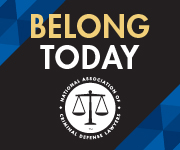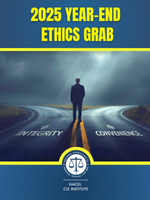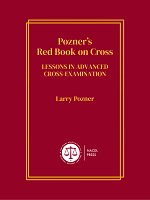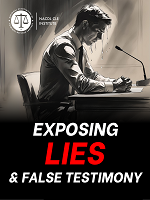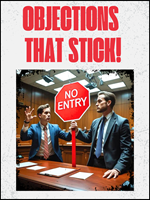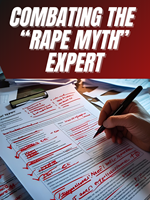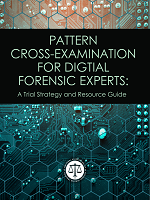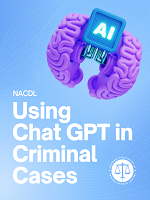Access to The Champion archive is one of many exclusive member benefits. It’s normally restricted to just NACDL members. However, this content, and others like it, is available to everyone in order to educate the public on why criminal justice reform is a necessity.
My first truly searing experience with federal prosecutors violating the Brady rule continues to sear today, nearly a quarter century after I was introduced to the case of United States v. Jeffrey R. MacDonald. Having practiced criminal defense law since 1967, I have, of course, run across the usual array of Brady violations, but nothing I saw before MacDonald, and nothing since, has disgusted me in the same way.
One day in 1989 I received a phone call from a prisoner who identified himself as a fellow Princeton graduate. We were on the campus for a while at the same time: I was in the class of 1964, and he was in the class of 1965 but in a three-year program. We probably crossed paths but made no note of it, or of each other. I was anti-Vietnam War and destined for law school, and he was in an accelerated program destined for medical school and then the Army as a trauma surgeon. We moved in such different academic and social circles that it would have been a very long shot for us to have run into each other, much less to have exchanged words. But now that both of us were out of school, we did have one thing in common. We each had a deep interest in the pitfalls of the criminal justice system — MacDonald from the vantage point of a prisoner sentenced to life for murder, and I as a criminal defense lawyer and writer about how the system sometimes goes off the rails.
MacDonald wanted me to take on his case. I was hesitant to get involved because I knew just enough about the case to realize it had the potential to ensnare me for years and to cost me a rather large amount of time and out-of-pocket funds. (I was too optimistic. It has now held me in its thrall for nearly a quarter century, and it is the most expensive free case I have taken in a long career of doing many free cases.) But MacDonald had taken the precaution of phoning my friend and former law school professor Alan Dershowitz and engaging his interest. I got the assent of my then-partner Andrew Good, along with then-associate Philip Cormier, now a partner of Good. We agreed to take on the case and share the work, although I took sole responsibility for the costs.
But the real burden of the case was not primarily financial; it was professional and, as it turned out, philosophical and psychological. The case would confirm all my worst suspicions about the criminal justice system in general, and the U.S. Department of Justice and the federal courts in particular. Beginning in the mid-1980s, I began noticing a perceptible shift in the culture of the federal criminal justice system. The public still clung to a weathered image of the DOJ and the federal courts as agents of change — protectors of civil rights and civil liberties, squeaky clean institutions in an otherwise corrupt sea of crooked cops and local courts. But the era of Attorney General Nicholas Katzenbach, hero of the Southern civil rights movement under Lyndon Johnson, had ended, and the era of John Mitchell, Richard Nixon’s dour and shadowy henchman, was in full flower. And the malign influence of J. Edgar Hoover has long survived his death.
Early in my career I would have had great difficulty believing that the feds would ever frame a military physician for the murder of his wife and two young daughters on an army base in North Carolina, even if they deeply believed that he was guilty. But by the time I agreed to take on the MacDonald case, I had seen the changes creeping in, and much as I believed we had powerful evidence to undergird our new trial motion under 28 U.S.C. § 2255,1 I figured we were in for a fight. How much of a fight, however, I could not imagine at the time, and I can barely comprehend it even now.
It would take an entire issue of The Champion to describe in sufficient detail the tortuous path of the MacDonald case through the federal criminal justice system.2 It has been described by many observers as the case that will not die. But the real question is whether the defendant, as well as his current legal team, will live long enough to see justice done.
The Murders And the Legal Proceedings to Date
Early in the morning of Feb. 17, 1970, military police responding to an emergency call arrived at Jeffrey MacDonald’s apartment in Fort Bragg, N.C. When they entered the apartment, they found McDonald, a Green Beret trauma surgeon, lying unconscious across his wife Colette’s dead, mutilated body. Their two young daughters were found stabbed and bludgeoned to death in their bedrooms. MacDonald told investigators that he had fallen asleep on the couch and awoken in the middle of the night to find four intruders standing over him — three men, including one in an army jacket, and a woman with long blonde hair, dark clothing and a floppy hat, holding a candle — and that the men proceeded to attack him with a club and stab him in the chest. MacDonald claimed that, after a struggle, he lost consciousness, and awoke some time later to the gruesome sight of his murdered family. He was then treated for his injuries, including a stab wound to the chest that partially collapsed one of his lungs.
This improbable story was not as improbable as it might seem to some: a first responder who heard MacDonald’s account of the murders reported that while he was en route to the MacDonald residence, he had seen a young woman with blonde hair and a floppy hat standing by the road — a woman soon identified as likely being local drifter, drug addict, and police informant Helena Stoeckley. But suspicions quickly grew that MacDonald himself had committed the murders and devised a story that would conjure images of the Charles Manson killings, suspicions bolstered by the discovery in the MacDonalds’ living room of an Esquire magazine issue containing a story about the deaths of Sharon Tate and several others at the hands of the “Manson family” just six months prior. Military investigators even began to suspect that MacDonald actually staged the scene to suggest a struggle with a band of hippie intruders. Instead of looking for evidence of intruders, military police began to focus their forensic investigations on a search for proof that MacDonald had committed the crime himself.3
Fingered by military police as the killer, MacDonald was soon brought to an Article 32 hearing, a preliminary military proceeding to determine what charges, if any, should be brought against a suspect for trial by court martial. The case could, and should, have ended there, because Col. Warren Rock, the presiding hearing officer, declared not only that there was insufficient evidence to proceed to a court martial of MacDonald, but, further, that “the matters set forth in all charges and specifications are not true.” Col. Rock further took the unusual step of suggesting an investigation of Helena Stoeckley. But MacDonald’s ordeal did not end there. Prosecutors at the Department of Justice thought they might be able to get him indicted and convicted in a civilian criminal court once he left the military.
That conviction would not come until 1979, almost 10 years after the murders. In the interim, the case made a procedural trip to the Supreme Court. In 1981, it made another. Although these two forays resulted in high court opinions, MacDonald did not prevail in either matter, though neither involved the merits of the case.4 Thus began decades of habeas corpus wrangling, still in progress today. MacDonald and a litany of lawyers have filed, in addition to a direct appeal, three petitions for a writ of habeas corpus, one in 1984, another in 1990 (which was reopened in 1997), and the last in 2005. Each habeas petition marks the presentation before the courts of a wave of newly discovered, previously suppressed or unknown evidence, including stark proof of prosecutorial misconduct and evidence suggesting the presence of intruders on the night of the murders, much of which was uncovered piecemeal by two major Freedom of Information Act (FOIA) requests. Since the failure of our 1990 habeas petition, each new motion has also been a renewed attempt to force the courts to view newly discovered evidence not in isolation, but rather in conjunction with previously admitted as well as previously excluded evidence in order to discern what the late Fourth Circuit Judge Francis Murnaghan described in a concurring opinion in 1982 as the “rounded picture,” which neither the jury nor the courts had seen before.5
The FOIA Expedition
MacDonald’s first habeas petition was denied by a panel of the Fourth Circuit Court of Appeals in 1985, and the Supreme Court denied certiorari in 1986. Two years later, MacDonald and an investigator named Ellen Dannelly began to sift through the thousands of pages of FOIA materials that the government had handed over in advance of MacDonald’s first habeas petition. MacDonald then retained FOIA expert Anthony Bisceglie, who filed additional FOIA requests with the Army, FBI, and DOJ. My colleagues and I came on board after Bisceglie began his FOIA work.
Late in the spring of 1990, Bisceglie received a phone call from the addled FOIA officer at the U.S. Army Criminal Investigation Records Division in Baltimore. The officer could not handle the massive quantity of FOIA materials requested by the MacDonald team, and offered to let the team spend a day searching through the documents themselves. This was an opportunity too good to miss, and the MacDonald habeas team jumped at it. On May 7, 1990, Bisceglie went to Baltimore, accompanied by Silverglate & Good paralegal John Murphy and author Fred Bost.6 What they discovered in the Army’s long-vaulted MacDonald file blew the whole case open, and led to our filing Murphy’s affidavit with 270 pages of attached exhibits in support of our 1990 habeas petition.
For the sole reason that a FOIA officer was too lazy, too confused or too busy to fulfill our request, we now had access to evidence that no juror, judge, or attorney retained by MacDonald had seen before. We had in our hands not only previously suppressed Brady material, but also documents that appeared to us to show how chief prosecutor Brian Murtagh maneuvered to make it unlikely that the jury would see that same exculpatory evidence.
The Puretz Memorandum
The Murphy FOIA materials supplied a wealth of exculpatory evidence. Some of it was forensic, some not. Foremost among the nonforensic pieces of evidence that made an impression on me was an innocuous-seeming memorandum that we called the “Puretz Memo,” named after a law student clerk who was working at the time in the U.S. Attorney’s Office and was helping the trial team, particularly DOJ lawyer Brian Murtagh, prepare for trial. The Puretz memo delineated the state of federal law regarding a prosecutor’s obligation to disclose to the defense any exculpatory evidence known to the prosecutor in accordance with the Brady7 case law promulgated by the Supreme Court, as well as the Fourth Circuit.
As the parties were preparing for the jury trial that began in July 1979, both sides recognized that various hairs and fibers found at the crime scene and then analyzed by military and government forensic scientists and technicians would be crucial to the case. At trial, MacDonald consistently maintained his original story of a woman intruder with long blonde hair and boots and floppy hat, holding a candle, whose three male friends proceeded to attack and injure MacDonald and to murder Collette MacDonald and the two children. If MacDonald’s seemingly bizarre story was to be believed, there would have to be some evidence at the scene suggesting the presence of intruders.
It was thus evident to counsel for both sides, prior to the commencement of trial, that the prosecution’s case would be substantially undermined to the extent that hairs and fibers could be located at the crime scene that could not be sourced or matched to any person, clothing, or other items belonging to the MacDonald family. The presence of fibers and hairs in the apartment for which there was no logical explanation — other than intruders — would be powerful proof that MacDonald was telling the truth. This would be particularly important with regard to hairs and fibers found in strategic locations, such as on the murder weapons, on the bodies of the victims or in their mouths, or under the fingernails of the victims (indicative not only of intruders but also of a struggle with the attackers). As we learned via FOIA, such hairs and fibers were in fact found in all of these revelatory locations.
The Puretz memo was a remarkably potent instrument by which the habeas team could attempt to reconstruct the prosecutor’s thinking as he was trying to figure out what to turn over, when to turn it over, what he could avoid turning over, and how to protect himself in the event things went awry and he later were to face an accusation of failure to turn over Brady material. After all, the lead prosecutor from the Department of Justice in Washington was dealing not only with an experienced trial judge (albeit one strongly biased against MacDonald), but also with a member of the local U.S. Attorney’s Office. And the government team was going up against an experienced and well-reputed duo of defense lawyers: Bernard L. Segal, a prominent Philadelphia-based civil rights lawyer, and Wade L. Smith, then as now one of the most talented trial lawyers in North Carolina. If corners were to be cut — or worse — in terms of not turning over all Brady material, the prosecutor was going to have to act in a manner that would allow him to defend himself and his actions if things later went wrong and Brady claims were made.
This is the context in which I viewed the Puretz memo when paralegal John Murphy brought it back from his enormously productive FOIA expedition. A prosecutor choosing not to turn over the kind of exculpatory forensic evidence that Murphy had found had to proceed very cautiously. The Puretz memo appeared to me to be a road map not for guiding the turning over of Brady evidence, but rather for either suppressing it or placing it in a context in which it was technically available to the defense (and hence technically not withheld) but unlikely to be found, much less properly evaluated for its exculpatory value. This was what I deemed a “needle in a haystack” strategy for providing Brady material hidden in plain sight. Many of the notes, memos, lab notations, and such that Murphy brought back had considerable exculpatory value, but the Puretz memo seemed to me then, as now, to be the single most revelatory item in the cache.
One of the questions Murtagh asked Puretz to address in the memo particularly struck my interest and provoked my skepticism:
Need the detailed data of a lab report, as distinguished from the conclusions of the report, be disclosed, where such conclusions have been disclosed and are nonexculpatory?
Why in the world, I asked myself, would a prosecutor bother having research done on such a question? If “the conclusions of the report” were not exculpatory and were disclosed, why would a prosecutor hesitate to simply turn over to defense counsel “the detailed data” underlying the nonexculpatory conclusions? I knew that Murtagh had refused to turn over lab bench notes to the defense, insisting instead that MacDonald’s lawyers make do with the finalized, typewritten lab reports. Could it be, I wondered, that there was something in the detailed data in the expert’s cache of evidence or in the expert’s bench notes made during the testing process that undermined the nonexculpatory conclusions in the report? This is how we stated it in our brief to the district court upon the filing of our October 1990 motion for a new trial: These questions became “particularly pregnant” once we discovered as a result of the Murphy FOIA expedition that “there were highly exculpatory laboratory bench notes (the ‘detailed data’) that were not reflected in the conclusory, typewritten, final reports.”
And then the prosecutor asked Puretz to answer still more questions that tweaked my interest: “What are the ramifications of an open-file policy of disclosure by the prosecutor?” and, further, “At what point in time must exculpatory materials be disclosed to the defense in a criminal proceeding?”
I could understand why such research might be commissioned after a trial, under circumstances in which, for example, the prosecutor (or the court, or the defense lawyer) suddenly discovered the presence of arguably exculpatory evidence that had been overlooked by the prosecutor and not turned over in time for the defense to use it at trial. At such a point, the prosecutor would be trying to protect a guilty verdict obtained after a trial that was less than constitutionally perfect where Brady material had been overlooked. But why would a prosecutor ask such questions prior to trial? If he knew of the existence of such evidence, why not just turn it over rather than commission research into the question of what it might do to undermine a guilty verdict if discovered post-verdict?
As we posed it in our opening October 1990 habeas brief: “Why would any prosecutor acting in good faith want research done, prior to trial, on the question of how long he could legitimately delay turning over exculpatory evidence before such delay or failure becomes a violation of the defendant’s rights or of the prosecutor’s legal obligations? Presumably, after all, if the prosecutor had made a decision to suppress the exculpatory evidence, he would not be asking any such question, and if he did not have suppression on his mind, he would not be asking how long he could delay.” As our brief suggested, “to do this research … in advance of trial, raises both questions and eyebrows.” 8
And why ask the student clerk to research the “ramifications of an open-file policy of disclosure?” The ramifications were quite obvious, were they not? If, after all, the prosecutor were to make available his complete file to the defense lawyer, would that not obviate any later claim of suppression under Brady?
And, further (again, from our 1990 habeas brief): “Why would a prosecutor, who up until the eve of trial vehemently resisted defense discovery requests seeking, inter alia, underlying laboratory bench notes, suddenly be interested in the ramifications of ‘an open-file policy of disclosure’ — especially where a true policy of open access by the defense to the government’s full files, including lab bench notes, would have disclosed exculpatory evidence that would have made the government’s case untenable?”
In fact, after long resisting anything that might be described as liberal discovery, the prosecutor did suddenly agree to a species of “open-file” discovery in which a huge cache of forensic exhibits were herded into a local jail cell, to which defense counsel and his forensic expert were given access a mere 13 days before trial.9 Of course, this cache contained only the physical evidence itself, which was copious, and did not contain the bench notes repeatedly requested by the defense.
Furthermore, the manner in which the government qualified its expert witnesses (stipulating, for instance, that one lab analyst who discovered exculpatory fiber evidence would testify only as a serology expert) made it highly unlikely that defense counsel, on cross-examination, would trip across the suppressed Brady material at the heart of this second habeas proceeding. All in all, we had discovered, and alleged, a very neat scheme by which the prosecutor could avoid turning over truly exculpatory evidence in a format that would be of practical use to defense counsel, all the while taking steps to protect himself against a later charge of failure to fulfill his obligations under Brady.
As a result of the failure of the prosecution to turn over Brady material in a format and at a time when it could be useful to the defense at trial, some enormously potent exculpatory evidence was not available for use by MacDonald’s lawyers at his trial and never made its way to the jury.
For example, let us go back to the young woman with the long blonde hair and a floppy hat. We learned that local drug addict Helena Stoeckley in fact owned a long, blonde wig that she was fond of wearing. And recall that a military policeman reported seeing a blond woman matching Stoeckley’s description standing on a street corner not far from the murder scene when he was en route to respond to MacDonald’s emergency call for help. Importantly, Stoeckley had repeatedly confessed to having been in the MacDonald residence on the night of the murders. At trial, Stoeckley testified that she owned a blonde wig and a floppy hat, and that she always wore black clothing, but claimed to have had memory loss concerning her whereabouts between midnight and 6:00 a.m. on the night of the murders. MacDonald’s lawyers attempted to present the jury with hearsay testimony of her multiple confessions to friends and acquaintances. Trial judge Franklin Dupree disallowed it due to a lack of corroborating evidence. What MacDonald’s lawyers did not know prior to trial — indeed, until the Murphy FOIA expedition — was that the government’s evidence files contained laboratory bench notes written by CID lab technician Janice S. Glisson that identified the presence of long, blonde synthetic wig hairs in a brush at the murder scene. In addition to bolstering MacDonald’s account of the murders, the presence of these blonde fibers would have corroborated the defense’s hearsay testimony and required Judge Dupree to allow the witnesses to Stoeckley’s repeated confessions to be heard by the jury. On direct appeal, Circuit Judge Murnaghan concurred with a Fourth Circuit panel’s ruling upholding MacDonald’s conviction, “albeit not without substantial misgiving,”10 but lamented the “withholding of collateral testimony consistent with and basic to the defendant’s principal exculpatory contention.”11 Little did Judge Murnaghan or MacDonald’s trial lawyers know at the time that the withholding of this testimony from the jury was enabled by defense counsel’s ignorance of the existence of corroborating forensic evidence of Stoeckley’s many confessions.
Recall that any fibers found at the murder scene that did not match any material known to belong to the MacDonald household would be suggestive of the presence of strangers at the crucial time and place. Defense counsel were utterly unaware that a government forensic expert, James Frier, had, at prosecutor Murtagh’s request, done some fiber re-examinations close to the start of the trial. Frier identified black wool fibers on the victim and on the club murder weapon; the fibers did not match any item of clothing or any other cloth item in the MacDonald household. This could lead to a reasonable conclusion that such strategically located fibers were from items of clothing worn by the intruders and were transferred to the murder weapon and to the victims in the murderous melee.
But MacDonald’s trial lawyers never learned of Frier’s findings; trial counsel denied ever having received a copy of Frier’s written report. We learned from Frier’s seemingly self-serving file memo Murphy brought back from the FOIA expedition that when Frier asked Murtagh if he — Frier — should deliver a copy of his report to MacDonald’s trial counsel, Murtagh had conveniently offered to pick up both copies of the report and to deliver a copy to MacDonald’s chief trial counsel, Segal, when the two of them were scheduled to get together a few days later. (Segal vehemently denied having been given a copy of the exculpatory Frier memo by Murtagh or anyone else before it was discovered via FOIA.) And when it came time for Frier to testify at trial, the prosecutor offered a stipulation as to his testimony, which was accepted by MacDonald’s lawyer, who had no idea what crucial exculpatory testimony was thereby being left out of the trial. Accepting the stipulation dashed any chance that the expert would be asked, or would tell the jury, about the black wool fibers.
And, as one might have expected from reading the Puretz memo, these vitally important pieces of forensic evidence, while absent from any reports turned over to defense counsel, were included in the huge cache of physical evidence locked in the jail cell that was made “available” to defense counsel 13 days prior to trial. The needle-in-the-haystack method proved very effective.
McCleskey v. Zant Intervenes
By 1991, we thought that we could, and would, make a very powerful habeas showing that would get MacDonald the new trial that had thus far evaded him. At such a retrial, we thought that gaining his acquittal would not be such a hard task, given the voluminous amount of exculpatory evidence that MacDonald’s investigators and our legal team had compiled. The evidence seemed to pile up by the day.
But when it came time for us to file our reply brief, something transformative occurred. Our brief was virtually complete. A couple of days before the filing due date in April 1991, I left for an appointment in New York while the rest of the team finalized the reply papers. I received a phone call in my hotel room, telling me that the Supreme Court had just released its decision in McCleskey v. Zant.12 The opinion held that defendants have the right to file only one habeas petition. Going forward, any second or successive petition would face a daunting array of procedural obstacles. Essentially, the petitioner would have to demonstrate cause for not having filed the new evidence with his earlier petition, and, incidentally, he would have to demonstrate actual innocence in order just to get an evidentiary hearing. It was no longer good enough to show that a defendant had an unconstitutionally unfair trial; he would also have to show, before he could get an evidentiary hearing, that he was innocent, or at least that “a fundamental miscarriage of justice would result from a failure to entertain the claim.”13
All of the years that have passed from the McCleskey ruling, right up until the Fourth Circuit opinion finally ordering the evidentiary hearing that began on Sept. 17, 2012, and ended a week and a half later, were spent fighting merely for the right to have such a hearing. Each successive habeas attempt — at least one of them provoking palpable annoyance on the part of the Fourth Circuit due to our suggestion that prosecutors had perpetrated a fraud on the court that the judges themselves had failed to spot14 — brought us a little closer to being able to force the courts to look at the picture as a whole. Such a rounded and full picture, we were confident, would lead any rational fact-finder to see that MacDonald was both wrongly convicted and actually innocent.
In a 2011 decision by the Fourth Circuit, the court appeared finally to have tired of the intricate procedural game that had prevented a judicial examination of the case’s merits for so long. It ordered an evidentiary hearing that would “include the previously excluded evidence … and may also include other evidence not mentioned, if it is part of the ‘evidence as a whole’ properly put before the court.”15 It has been almost 30 years since Circuit Judge Murnaghan expressed his discomfort with this case, and only now, after decades of litigation, will MacDonald perhaps have an opportunity to focus the courts on the full picture. The case likely will be decided, finally, when it again reaches the Fourth Circuit.
Conclusion
The tragedy of the MacDonald case — three human beings slaughtered and the bereaved survivor suffering half his life in prison for crimes that the full panoply of evidence shows he did not commit — is a tale of what can happen when defense counsel is not allowed reasonable, fair access to evidence secured in the prosecution file. The Brady rule, in theory, should have been transformative of state and federal criminal trial practice. The percentage of wrongful convictions should have been radically reduced by promulgation of this salutary rule by the Supreme Court. But the difficulties enforcing Brady’s command, combined with the limitations imposed on the writ of habeas corpus by both Supreme Court opinion and legislation, have transformed a promised remedy for injustice into a sometimes cruel illusion.
The author acknowledges with thanks the advice and assistance, in the preparation of this piece, of co-counsel in the MacDonald case, Philip G. Cormier; author, sleuth, and documentarian Errol Morris; and paralegals Zachary Bloom and Juliana DeVries.
Notes
- The MacDonald case was a relatively rare federal murder prosecution because the crime took place at Fort Bragg, N.C., a federal military base.
- The mind-boggling procedural history was most recently laid out by the Fourth Circuit in United States v. MacDonald, 641 F.3d 596; 2011 U.S. App. LEXIS 7914 (April 19, 2011).
- The botched investigation of the MacDonald murder scene is described in vivid detail in Errol Morris’s recent book about the case, A Wilderness of Error (2012).
- United States v. MacDonald, 435 U.S. 850 (1978) (holding that the Fourth Circuit lacked jurisdiction to grant before trial MacDonald’s motion to dismiss on speedy trial grounds); United States v. MacDonald, 456 U.S. 1 (1982) (holding that the passage of time between the dismissal of MacDonald’s military charges and the return of the federal indictment did not violate MacDonald’s speedy trial rights).
- United States v. MacDonald, 688 F.2d 224, 234 (4th Cir. 1982)
- Bost, who died on Jan. 8, 2013, was co-author, with Jerry Potter, of Fatal Justice (1995), a dense but thorough re-examination of the MacDonald case aimed at refuting the sophistry of Joe McGinniss’s best-selling pop account of the case, Fatal Vision (1983).
- Brady v. Maryland, 373 U.S. 83 (1963).
- Emphasis in original.
- For the reader interested in how all of this played out at trial and in the years since, a wealth of documents can be found at www.wildernessoferror.com.
- United States v. MacDonald, 688 F.2d 224, 234 (4th Cir. 1982).
- Id. at 236.
- McCleskey v. Zant, 499 U.S. 467 (1991).
- Id. at 495. In 1996, in a frenzied response to the first World Trade Center attack and the Oklahoma City bombing, Congress enacted the Anti-Terrorism and Effective Death Penalty Act, which codified in legislation some of the limitations on habeas corpus set forth in McCleskey.
- United States v. MacDonald, 1998 U.S. App. LEXIS 22073 (4th Cir., Sept. 8, 1998).
- United States v. MacDonald, 641 F.3d 596, 614 (4th Cir. 2011).

